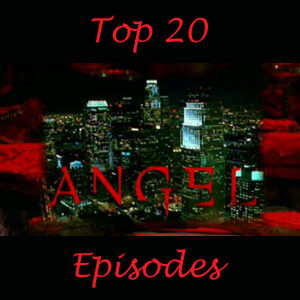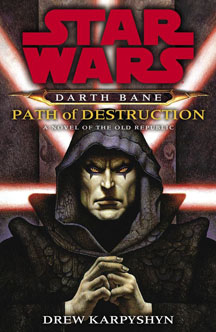Darth Bane’s presence in the Disney canon is sparse: Terry Brooks introduced him as the originator of the Rule of Two (one Sith master, one apprentice) in the “Phantom Menace” novelization, then Mark Hamill voiced the specter of Bane, taunting Yoda, in “The Clone Wars” Season 6 finale. In the Legends universe, however, Drew Karpyshyn’s work with the character is, well, legendary, particularly “Darth Bane: Path of Destruction” (2006).
The novel, the first of what became a trilogy, calls to mind A.C. Crispin’s backstory of Han Solo – but morally reversed. Whereas Han goes through dark moments before emerging into the light with the Rebellion, Bane – originally known as Des – has to overcome bouts with the light side while training at the Sith Academy at Korriban. He kills a fellow student in a challenge match – something that’s only mildly frowned upon by his teachers – and questions whether he should have held back. For months, he goes into a funk where he’s unable to fully tap into the dark side.
Bane only briefly questions whether his life would’ve turned out differently if he had a different upbringing. But to readers, it’s clear that Bane’s is a case of “nurture” rather than “nature.” He grows up on Apatros, an indentured-servitude mining planet where his father blames him for their lot in life and regularly beats him. His father also gives him the derogatory name Bane, which the son later claims for himself so no one can use it against him. Then Bane stows off-planet to join the Sith army, and – when his Force abilities become obvious – is trained on Korriban.
Because he clearly had the potential to be a good person, and because all his rivals are bad people too, I oddly found myself rooting for Bane every step of the way. Sure, he occasionally fights the ostensible good guys – the Republic and Lord Hoth’s Army of Light – but his primary target is the Brotherhood of Darkness and its increasingly off-kilter leader, Lord Kaan.
Crispin’s Han Solo books were masterful for how they smoothly linked to other EU works, and Karpyshyn shows a similar knack. Bane studies the 3,000-year-old texts of Darth Revan in the Korriban academy and a Revan holocron on an unauthorized field trip to the Unknown World, a.k.a. Lehon, a.k.a. Rakata Prime. Revan was the main character of the “Knights of the Old Republic” game, written by Karpyshyn. (Later, the author would further explore the character in the novel “The Old Republic: Revan.”)
While Revan didn’t exactly subscribe to the Rule of Two, he didn’t spread out his power among an army of “equals” like Kaan is doing, something Bane finds inconsistent with Sith philosophy and therefore doomed to fail. Bane is the fulcrum between Revan’s ancient teachings and the rise 1,000 years after his time of Darth Sidious, who finally personifies Bane’s tenet that the Sith will only prevail with cunning and deception.

What’s bizarre – but also kind of appealing — about Bane is that he never thinks about ruling the galaxy. He sees the Sith Order as destroying itself and schemes to preserve its philosophy by claiming its power for himself (and one apprentice). But he has no plans beyond that, at least not in “Path of Destruction.” Still, it’s not necessarily a contradiction: A consistently intelligent person, Bane could simply be aware that he’s not yet ready to make a power play for galactic rule, and he’ll continue to hone his knowledge and skills until he is.
The most famous connections in “Path of Destruction” are to the “Dark Forces: Jedi Knight” illustrated novel and the “Jedi vs. Sith” comic series. “Jedi Knight” introduced the Seventh Battle of Ruusan and the thought bomb that ended it. Then “Jedi vs. Sith” added the tragic tale of Rain, a.k.a. Zannah, falling to the dark side amid the turmoil of the battle. While the comic included Darth Bane, “Path of Destruction” allows us to better understand the reasoning behind Bane’s scheming and also smooths out a few minor plot holes. “Path of Destruction’s” final act is the definitive portrayal of the Battle of Ruusan, but I’d recommend fans also check out “Jedi vs. Sith” for more on Zannah, who will factor into the Bane trilogy’s second book, “The Rule of Two.” (“Jedi Knight” is skippable, unless you’re curious to read the earliest form of this story, and to know that the souls trapped in the thought bomb eventually are set free.)
“Path of Destruction” has the comforting, familiar structure of a coming-of-age story with lessons, teachers, obstacles and all that good stuff. Trudging into the dark side isn’t as unappealing as one might think; in fact, it’s rather amusing the way the author simply flips the script by having Bane struggle with the light side in his journey to becoming a Sith lord. Throw in the masterful way Karpyshyn expands upon “Jedi vs. Sith,” and you’ve got a popular page-turner, so much so that it led to two more books that weren’t initially planned.

